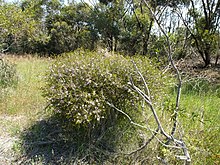This is an old revision of this page, as edited by Gderrin (talk | contribs) at 07:19, 27 August 2021 (Add POWO ref.). The present address (URL) is a permanent link to this revision, which may differ significantly from the current revision.
Revision as of 07:19, 27 August 2021 by Gderrin (talk | contribs) (Add POWO ref.)(diff) ← Previous revision | Latest revision (diff) | Newer revision → (diff) Species of shrub
| Melaleuca camptoclada | |
|---|---|

| |
| Scientific classification | |
| Kingdom: | Plantae |
| Clade: | Tracheophytes |
| Clade: | Angiosperms |
| Clade: | Eudicots |
| Clade: | Rosids |
| Order: | Myrtales |
| Family: | Myrtaceae |
| Genus: | Melaleuca |
| Species: | M. camptoclada |
| Binomial name | |
| Melaleuca camptoclada F.C.Quinn | |
Melaleuca camptoclada is a shrub in the myrtle family, Myrtaceae and is endemic to the south-west of Western Australia. It was first described in 1990 in a review of the genus Melaleuca when the species Melaleuca laxiflora at that time was found to comprise ten species. Two of those species were new - M. camptoclada and M. ctenoides.
Description
Melaleuca camptoclada is a shrub growing to a height of about 3 m (10 ft). Its leaves and branches are glabrous or almost so. The leaves are 2.9–5.5 mm (0.1–0.2 in) long and 1.5–1.8 mm (0.06–0.07 in) wide and elliptical in shape.
The flowers are mauve and are arranged in heads or spikes to 16 mm (0.6 in) in diameter, with 5 to 15 individual flowers. The petals are 1.5–2.4 mm (0.06–0.09 in) long and fall off as the flowers open. The stamens are arranged in five bundles around the flower with 9 to 16 stamens in each bundle. Flowering occurs from September to November and the fruit are woody capsules, 2.5–3.5 mm (0.098–0.14 in) long.


Taxonomy and naming
Melaleuca camptoclada was first formally described in 1990 by F.C.Quinn from a specimen found near the Stirling Ranges. The specific epithet (camptoclada) is from the Greek camptos, (flexible or curved) and clados (a shoot or branch), referring to the habit of this species.
Distribution and habitat
This melaleuca occurs in the Esperance Plains, Jarrah Forest and Warren biogeographic regions. It grows in gravelly sand and clay loam.
Conservation status
Melaleuca camptoclada is listed as "not threatened" by the Government of Western Australia Department of Parks and Wildlife.
References
- "Melaleuca camptoclada". Plants of the World Online. Retrieved 27 August 2021.
- Cowley, KJ; Quinn, FC; Barlow, BA; Craven, LA (1990). "Contributions to a revision of (Myrtaceae): 7–10". Australian Systematic Botany. 3 (2): 165. doi:10.1071/SB9900165. Retrieved 21 March 2015.
- ^ Brophy, Joseph J.; Craven, Lyndley A.; Doran, John C. (2013). Melaleucas : their botany, essential oils and uses. Canberra: Australian Centre for International Agricultural Research. p. 111. ISBN 9781922137517.
- "Melaleuca camptoclada". APNI. Retrieved 21 March 2015.
- ^ "Melaleuca camptoclada". FloraBase. Western Australian Government Department of Biodiversity, Conservation and Attractions.
- Paczkowska, Grazyna; Chapman, Alex R. (2000). The Western Australian flora : a descriptive catalogue. Perth: Wildflower Society of Western Australia. p. 392. ISBN 0646402439.
| Taxon identifiers | |
|---|---|
| Melaleuca camptoclada | |